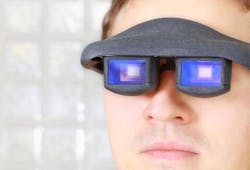Dresden, Germany--The Innovation Award IT 2013 (http://www.cebitaward.de/) in the category "hardware" was presented to Fraunhofer Research Institution for Organics, Materials and Electronic Devices (Fraunhofer COMEDD) on March 5th, 2013 during the information technology and digital communications show CeBIT 2013 (http://www.cebit.de/home) in Hanover, Germany for its head-mounted display (HMD) (http://www.laserfocusworld.com/articles/print/volume-48/issue-04/features/free-form-optics-enable-lightweight-head-mounted-displays.html)—also called heads-up display, head-worn display, or helmet-mounted display—glasses.
Rigo Herold, system designer at Fraunhofer COMEDD and principal designer of the organic light-emitting diode (OLED)-based HMD glasses, said, "This award shows especially that—apart from Google [http://www.laserfocusworld.com/articles/2012/04/google-project-glass.html]—intensive research on data eyeglasses is done also in Germany. However, our OLED data eyeglasses have a sensational unique feature: They can be gaze-controlled by the user's eyes. My special thanks go as well to our partners Fraunhofer IOSB and Trivisio."
Microdisplays based on OLED technology are considered to have a promising future for multimedia applications like video and data display, especially since they offer the possibility of integrating highly efficient light sources with photodetectors on a CMOS backplane. This enables fully integrated optoelectronic applications based on silicon. As a result, one can realize microscale optical emitters and receivers on the same chip for a bidirectional microdisplay that presents and captures images at the same time.
These COMEDD HMDs present information to the user and at the same time optically recognize interaction by the user. He or she perceives the environment in the normal way, but additional information is presented via the bidirectional microdisplays for augmented reality (AR). This visual information can be deliberately or unconsciously adapted to the context of operation of the system and the user can interact without using hands or speech, but only using movements or actions of the eyes. This results in personalized, mobile, interactive, see-through AR displays.
The OLED data eyeglasses of Fraunhofer COMEDD convinced a professional jury of 100 professors, scientists, industrial representatives, IT experts and journalists that the glasses are innovative, have practical relevance, and are especially suitable for medium-sized companies. Altogether there were 4,900 submissions in 40 categories. The embedded camera of the microdisplay captures the eye movements of the user so that he/she can control and interact with the virtual information shown, similar to a computer mouse.
Apart from Fraunhofer COMEDD the development team included Fraunhofer IOSB, responsible for eye tracking, and Trivisio Prototyping GmbH for the optics design. The data glasses can be used in a broad range of applications from medical and military or to support hand-free assembly work that requires additional information. Evaluation kits and customized HMD technology is available from Fraunhofer COMEDD at http://www.interactive-see-through-hmd.de.
SOURCE: Fraunhofer COMEDD; http://www.comedd.fraunhofer.de/en/news/press/2013/2013-03-08.html

